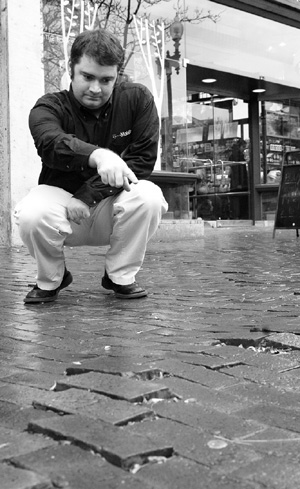Brick sidewalks head for a fall

Eli Reusch, who works at T-Mobile, points out patches of protruding bricks in November 2005 in front of the Harvard Square store. Reusch says that he sees four to six people a day stumble on the bricks, including some serious injuries. (Photo: Schuyler Pisha)
Cambridge has a sidewalk improvement plan that involves more than $9 million in upgrades over five years. In the meantime, people are tripping and falling along the city’s historic walkways.
The City Council decided Monday to look for an alternative to the bricks, which require constant maintenance and are often pushed up by tree roots.
The council did not suggest materials to City Manager Robert Healy and Public Works Commissioner Lisa Peterson, other than that they should be more attractive than plain concrete but more practical than brick. Healy said that if it were up to him, “all the sidewalks would be concrete.”
Councilor Henrietta Davis pointed out that people fall on concrete sidewalks as well — she has, in fact — and councilor Anthony Gallucio said “Brick is part of the historic nature of Cambridge.”
Healy said it comes down to the tree roots. “Do you want trees, or do you want to cut the roots and level the sidewalk?” he asked.
City councilors were not the only people concerned about brick sidewalks needing attention.
At Harvard Square, in an area nearing major improvements anyway, people were stumbling yesterday on a stretch of sidewalk with a 12-foot raised section shooting across the bricks near a tree and T station entrance.
“People trip every day,” shopper John Johnson said. “Tourists trip all the time. It’s been like this for two or three years. And it will be like this until somebody from the city comes and does something about it.”
According to nearby business owners and store employees, women get their high heels caught in the cracks between the bricks regularly. A few bricks are missing and the hole is camouflaged by fallen leaves.
People of all ages trip at the rate of about 10 per hour, said Eli Reusch, a sales manager at the T-Mobile cell phone shop, where a glass front provides excellent viewing of regrettable occurrences.
Two days ago, Reusch said, an elderly woman tripped on the raised section of loose bricks, going head over heels and tumbling across the square. People rushed to help her.
“It’s the most treacherous terrain that I’ve seen,” Reusch said. “It might be the roots that are causing it.”
He said it’s a good thing people are in shape in Cambridge. Otherwise someone might have been seriously hurt.
Even the elderly woman who went rolling through the square got up and “walked it off,” testament to the toughness of Cambridge residents.
“I don’t think it is a serious public hazard,” he said of the bad sidewalks. “But it is a nuisance.”
He added that he likes the trees in Harvard Square and doesn’t want to have them taken out because their roots are pushing up the bricks.
“I don’t want to see the trees leave the square,” he said. “But I don’t want to sacrifice safety for aesthetics.”
A group of citizen gadflies spoke before the council meeting addressed the issue, saying the bricks are dangerous to people with disabilities. City officials have already considered this, according to Healy’s report. The city has categorized sidewalk repairs as either part of significant roadway and utility improvement projects or as smaller-scale projects handled through the sidewalk inspection and repair program.
The problems are assessed based on “vertical displacement,” with anything greater than one and a half inches being considered “significant.”
Sidewalk repairs are prioritized, according to city policy, with areas of high pedestrian volume or near transit stations or elderly housing getting faster repairs.
As for the trees, the roots can be removed, or areas can be bridged with asphalt or pavers, or the city can install a root barrier system in conjunction with the sidewalk repair.
Some cities use fake brick “pavers,” a material that contains a colored polymer and is stamped before hardening with a brick design.
The council leaves the question of what material to chose in place of brick up to the transportation, parking, and traffic committee.
“I know it is a daunting task,” Davis said, referring to finding an answer to the sidewalk problems. “But to me it seems there are a lot of questions that come up again and again.”
Davis said she wanted to know how city officials are able to identify areas that need repair.
Healy explained that the Department of Public works does an assessment of the needs, which the city follows when making repairs to the bricks.
Councilor Denise Simmons stressed that the city should stay on top of the sidewalk issue:
“Can we be more diligent?” Simmons wondered regarding the upkeep of the sidewalks, especially in the area of the senior center.
